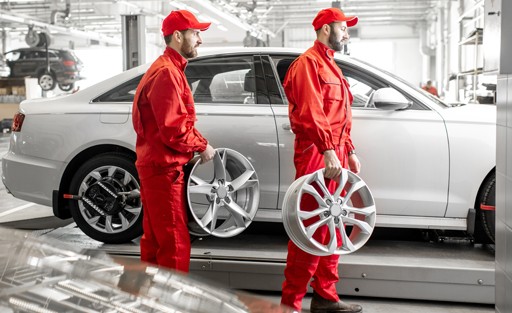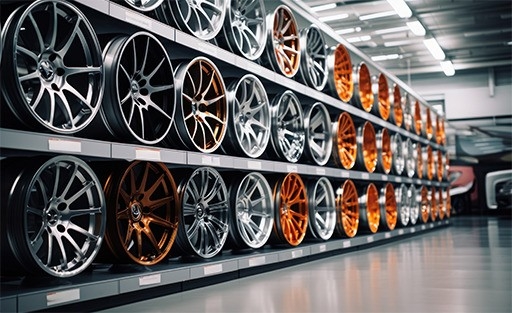
January 16, 2023
7 Tips for Buying the Right Rims for Your Car
Nothing transforms your ride's looks faster than brand-new wheels winking in the sunlight. For some, these sleek and shiny metal rollers don't just keep their cars moving; they are also a source of pride and satisfaction.
But before browsing through rims and tyres for sale, you need to realise that wheels don't just make your car look fantastic; they also affect overall performance, including handling and comfort. Most important of all, wheels impact your safety, which is why you should know what to look for.
7 Tips for Buying Wheels
While checking out tyre rims for sale, you spot a design that would look awesome on your car. But is it technically compatible with your ride? To avoid mistakes that cost time and money, read our important pointers.
1. Prioritise the bolt pattern.
Examine the bolt or stud pattern of your old wheels. Your new wheels should match it, or else you won't be able to mount them. You should look for two things: the number of bolts and the distance between the two bolts at opposite ends. Here's a diagram to guide you.
You can find the bolt pattern measurement on the wheels or in your owner's manual. For instance, a bolt pattern of 6/4.5 or 6x4.5 means the following:
• The first number 6 refers to the number of mounting holes.
• The second number 4.5, expressed in inches (or 11.4 centimetres), is the distance between two opposite holes.
2. Get the correct rolling diameter.
A tyre's rolling diameter, also called overall or outside diameter, is the sum of the sidewall height multiplied by two (since each tyre has two sidewalls) and the wheel diameter. Look at your tyre's sidewall numbers for the measurements. For example, a code of 195/65R15 reveals these values:
The first number 195 is the section width in millimetres.
The second number 65 is the sidewall's section height in relation to the tyre width and is expressed as a percentage. To get the sidewall height, multiply this value expressed in millimetres by the section width.
195 x .65 = 126.75 millimetres is the sidewall height.
But the above value is only for one sidewall. Because each tyre has two sidewalls, we multiply it by 2.
126.75 x 2 = 253.5 millimetres is the height of two sidewalls.
The last number 15 is the wheel diameter in inches. If you convert it to millimetres, the value would be 381 millimetres. Now, you can add the two values.
126.75 millimetres + 253.5 millimetres = 380.25 millimetres or 15 inches is your rolling diameter.
If you fit the wrong wheel size, you change their rolling diameter, which, in turn, affects handling, safety, and even the readings on your speedometers and odometers! For tyre upsizing to be safe, the new overall diameter of the tyre should not exceed 3% of its original value.
3. Pay attention to the offset.
Watch out for their offset or the measurement from the wheel's mounting hub to the centre line when changing wheels. Here's a quick lesson on offset types:
Zero offset - The centre line is aligned with the wheel's mounting surface.
Positive offset - The mounting surface sits further out than the centre line, so your tyre sits deeper on your axle.
Negative offset - The mounting surface sits on the outer side of your wheel's centre line.
Offset changes the wheel's appearance, but getting it wrong can damage your suspension, tyres, and wheels. If you're changing wheels, Tyroola recommends an offset of not more than 5 millimetres from its original offset fit, which you can find at the back of the wheel or on your wheel brand's website. Just look for the letters ET—the numbers before or after ET gives the offset in millimetres.
Also read: Wheel Offset: Your Complete Guide
4. Upsize with care.
Bigger wheels are undoubtedly eye-catching, but bigger doesn't necessarily mean better. Remember that the bigger wheels and tyres, the heavier they get. When this happens, your ride may be harsher because of the additional weight on your suspension. If you upsize the wheels, you must change your tyres with lower sidewalls to maintain the right rolling diameter. However, less rubber on your tyres means less shock-absorbing ability and protection against road hazards and debris.
Also read: Your Complete Guide to Upsizing Tyres
5. Choose between alloy and steel wheels.
Both wheel types have their pros and cons. While alloy wheels are more expensive, less durable, and difficult to repair, they come in varied and appealing designs and give better performance and fuel economy. On the other hand, steel wheels are sturdier against damage, more affordable, and easier to repair. However, they don't look like the wheels you see in James Bond movies. Steel wheels don't come in sleek designs; they use up more fuel because they're heavier.
Here's a quick graphic to guide you:
Also read: What's the Difference Between Steel and Alloy Wheels?
6. Buy within your budget.
Wheels are costly, especially when you buy them as a set, which can set you back from hundreds to thousands of dollars. The fancier they are, or if you go for customisation, the pricier they get. Remember to factor in the wheel installation fees in your budget.
7. Only purchase from reputable shops.
A dizzying array of wheels is available so that you may get overwhelmed. But if you buy from tried-and-tested stores, you will get original, brand-new, dependable wheels. Aside from tyres, Tyroola also offers branded wheels for any budget and style. These wheels have passed the Australian Design Rules, ensuring their quality and durability. Buying cheap or fake ones compromises your safety because wheels constantly handle heavy loads and driving impacts. When a wheel breaks, you lose control of your ride.
Buy Rims Online!
Buying your wheels at Tyroola can save you time, effort, and money. Because we operate online, we can afford to sell our tyres and wheels at much lower prices. You can purchase without leaving home, and with our flexible payment schemes using Afterpay, Paypal and many more, you can enjoy your wheels now and pay later.
Shop at Tyroola for the best deals online!









